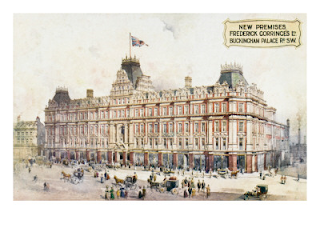|
The next entry is Georgina Fanny Cheffins who was born in 1864 in St John’s Wood, London. Georgina was the daughter of Charles, a civil engineer, and Mary. The family lived at 72 Boundary Road. Georgina was their eldest child, followed by three sons and two daughters. When the 1881 census was taken the family had moved to live in Dulwich. During the following ten years, the family moved to an area of Gillingham in Kent known as the Grange. The reason for the move was that Charles had entered into a partnership to manufacture Portland cement at a new plant to be built in Gillingham. Mary, their mother, passed away just before the census was taken in 1891. The family continued to live there, although, the cement business was acquired by another company in 1893, until Charles’s death in 1902. Georgina’s younger brother, George, died in 1898. The 1901 census records Georgina and Eva Lewis living in Lower Gornal, just to the west of the town of Dudley in the West Midlands. The two were running the St James’s Mission which appears to be affiliated with the parish church. They described themselves as lay sisters. Evangeline (Eva) was born in Brockville, Canada. Her father ultimately was appointed Archbishop of Ontario. He made frequent trips to England to raise funds for his work and for the sake of his health. One daughter married Llewelyn Loyd, who owned the Lillesden estate in Kent, and another lived in Cheltenham. Following Eva’s mother’s death and her father’s remarriage, it may be that the sisterly ties brought Eva to England. Both Georgina and Eva successfully evaded the 1911 census. Georgina was arrested in March 1912 for breaking eleven windows at Gorringe’s department store valued at £110. I In court, Georgina explained that she was ‘a suffragist absolutely by conviction’ because after living and working among the poor for more than twenty years she had come to the conclusion that all efforts were absolutely futile without the benefit of the franchise.’ Her militancy was the way of the WSPU and she was ‘firmly convinced’ it was the only way. Georgina closed by saying ‘her protest [was] because of the sweated women and the women and children ruined and broken every day of the year.’ She was sentenced to four months in prison. Georgina and Eva had, by then, moved to Hythe in Kent and joined the town’s WSPU branch. At a meeting, held while Georgina was in prison attended by Eva, the Hythe branch resolved to form a club, The Suffrage Club, which would bring together, for discussions, both the WSPU and the New Constitutional Society for Suffrage with aim of all suffrage campaigners being welcome. It would commence as soon as Georgina, who was appointed treasurer, was released from prison. Muriel de la Warr, accompanied by her daughter, Idina, officially opened the club, located on Hythe High Street with a shop and a room at the rear for meetings of The Suffrage Club, in August 1912. The window ‘was hung with purple, white and green’ with a counter and tables draped in the same colours. Georgina went on hunger strike, while in prison, and was forcibly fed. She was, on release, awarded the hunger strike medal. While in prison, Georgina was one of the signatories whose name was embroidered on the Suffragette Handkerchief now held by the Priest House in West Hoathly. Kate Perry Frye, a suffrage campaigner, wrote a diary, published by Francis Boutle Publishers and edited by Elizabeth Crawford, which mentions both Georgina and Eva and the support they gave to the campaign.
In 1916 Georgina successfully passed a First Aid exam held by the St John’s Ambulance in connection with the war effort. At some point, the two women moved from Seabrook Road to a smaller bungalow called Hymora where they lived until Eva died in 1928. Georgina died in 1932.
1 Comment
|
Categories
All
|
Proudly powered by Weebly




 RSS Feed
RSS Feed
